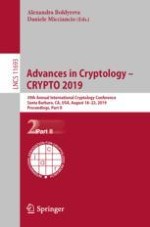2019 | OriginalPaper | Buchkapitel
The Distinction Between Fixed and Random Generators in Group-Based Assumptions
verfasst von : James Bartusek, Fermi Ma, Mark Zhandry
Erschienen in: Advances in Cryptology – CRYPTO 2019
Aktivieren Sie unsere intelligente Suche, um passende Fachinhalte oder Patente zu finden.
Wählen Sie Textabschnitte aus um mit Künstlicher Intelligenz passenden Patente zu finden. powered by
Markieren Sie Textabschnitte, um KI-gestützt weitere passende Inhalte zu finden. powered by
Abstract
-
In the generic group model, we demonstrate the plausibility of groups in which random-generator DDH (resp. CDH) is hard but fixed-generator DDH (resp. CDH) is easy. We observe that such groups have interesting cryptographic applications.
-
We find that seemingly tight generic lower bounds for the Discrete-Log and CDH problems with preprocessing (Corrigan-Gibbs and Kogan, Eurocrypt 2018) are not tight in the sub-constant success probability regime if the generator is random. We resolve this by proving tight lower bounds for the random generator variants; our results formalize the intuition that using a random generator will reduce the effectiveness of preprocessing attacks.
-
We observe that DDH-like assumptions in which exponents are drawn from low-entropy distributions are particularly sensitive to the fixed- vs. random-generator distinction. Most notably, we discover that the Strong Power DDH assumption of Komargodski and Yogev (Komargodski and Yogev, Eurocrypt 2018) used for non-malleable point obfuscation is in fact false precisely because it requires a fixed generator. In response, we formulate an alternative fixed-generator assumption that suffices for a new construction of non-malleable point obfuscation, and we prove the assumption holds in the generic group model. We also give a generic group proof for the security of fixed-generator, low-entropy DDH (Canetti, Crypto 1997).
